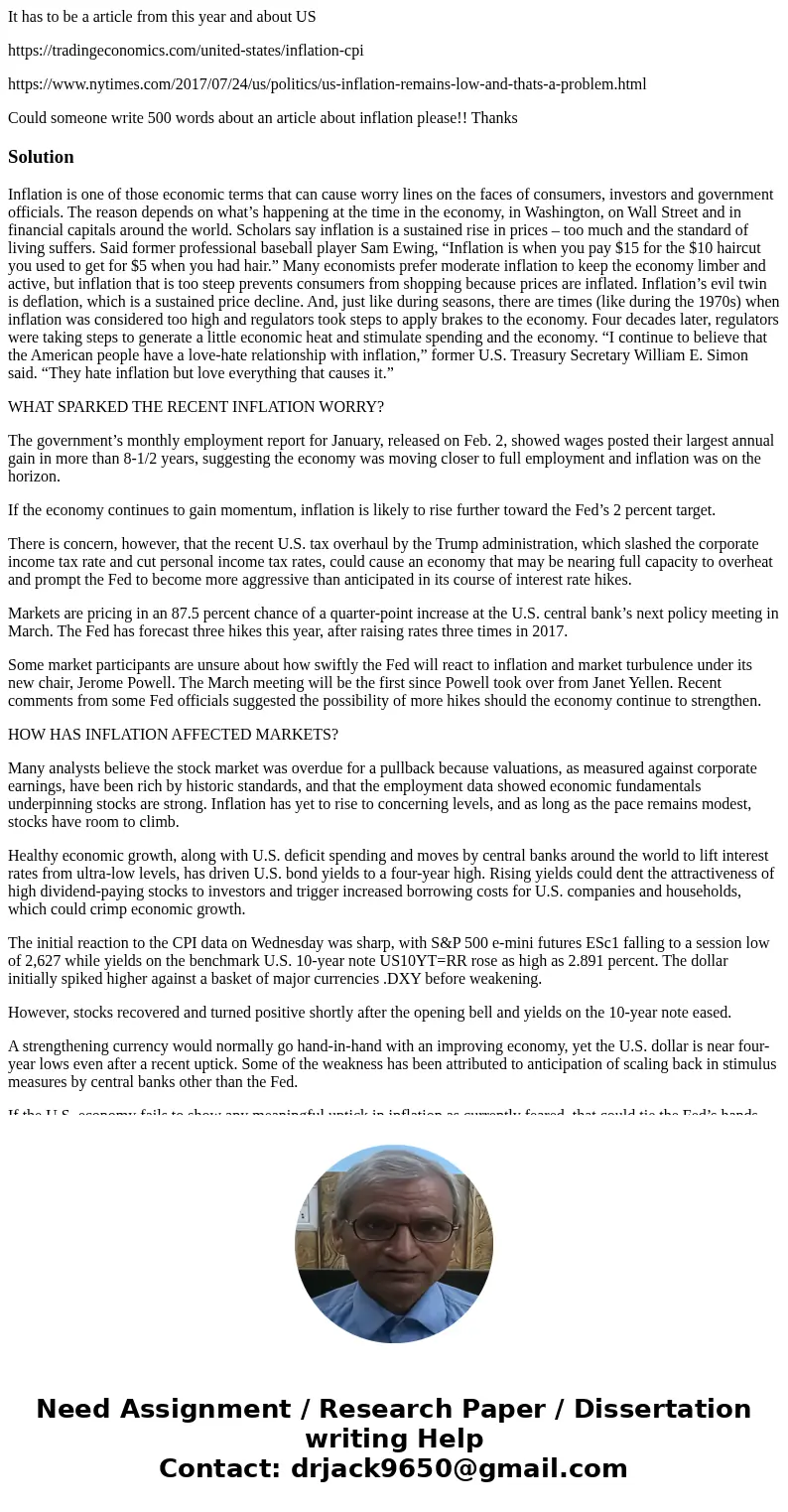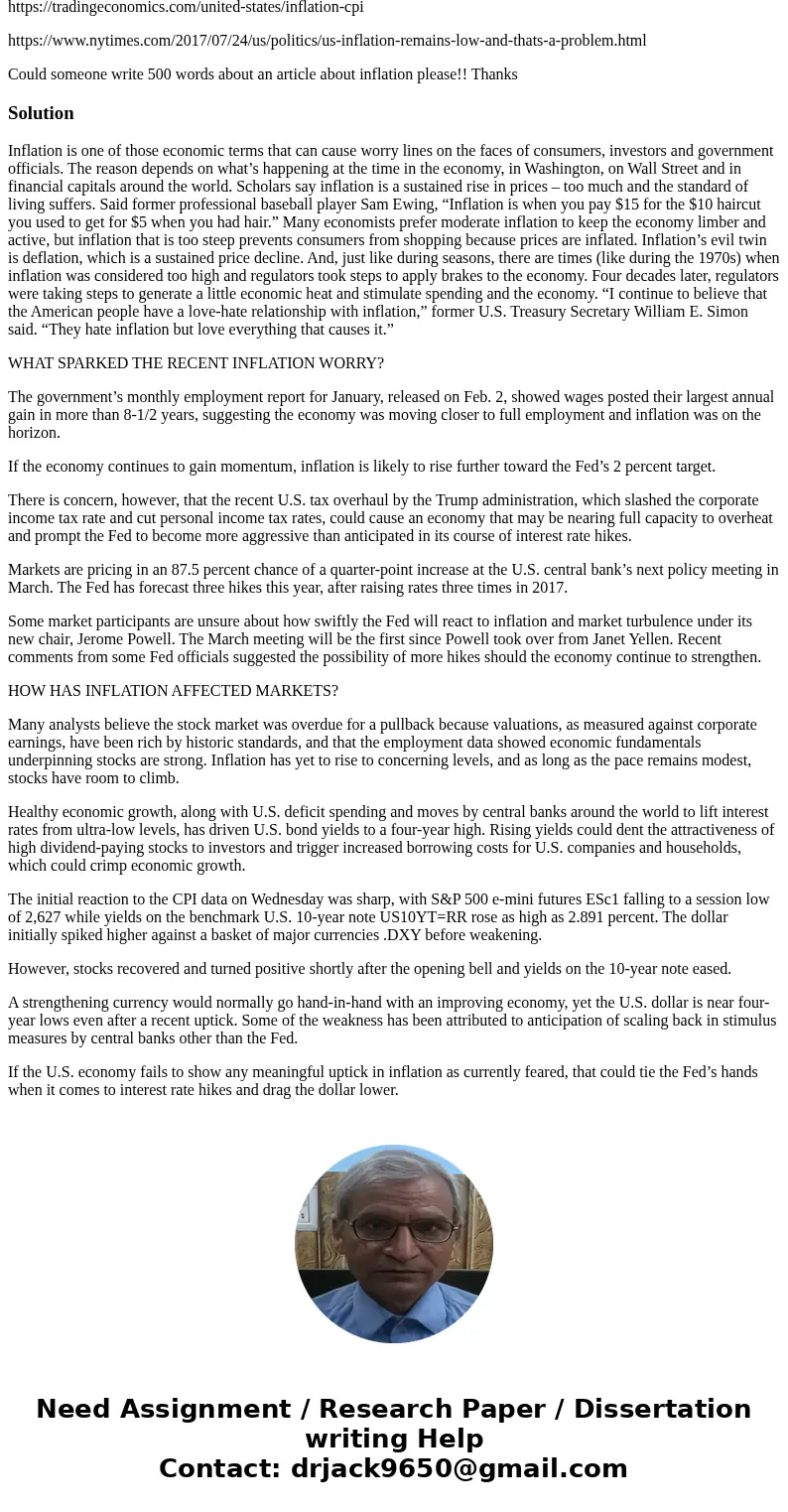It has to be a article from this year and about US httpstrad
It has to be a article from this year and about US
https://tradingeconomics.com/united-states/inflation-cpi
https://www.nytimes.com/2017/07/24/us/politics/us-inflation-remains-low-and-thats-a-problem.html
Could someone write 500 words about an article about inflation please!! ThanksSolution
Inflation is one of those economic terms that can cause worry lines on the faces of consumers, investors and government officials. The reason depends on what’s happening at the time in the economy, in Washington, on Wall Street and in financial capitals around the world. Scholars say inflation is a sustained rise in prices – too much and the standard of living suffers. Said former professional baseball player Sam Ewing, “Inflation is when you pay $15 for the $10 haircut you used to get for $5 when you had hair.” Many economists prefer moderate inflation to keep the economy limber and active, but inflation that is too steep prevents consumers from shopping because prices are inflated. Inflation’s evil twin is deflation, which is a sustained price decline. And, just like during seasons, there are times (like during the 1970s) when inflation was considered too high and regulators took steps to apply brakes to the economy. Four decades later, regulators were taking steps to generate a little economic heat and stimulate spending and the economy. “I continue to believe that the American people have a love-hate relationship with inflation,” former U.S. Treasury Secretary William E. Simon said. “They hate inflation but love everything that causes it.”
WHAT SPARKED THE RECENT INFLATION WORRY?
The government’s monthly employment report for January, released on Feb. 2, showed wages posted their largest annual gain in more than 8-1/2 years, suggesting the economy was moving closer to full employment and inflation was on the horizon.
If the economy continues to gain momentum, inflation is likely to rise further toward the Fed’s 2 percent target.
There is concern, however, that the recent U.S. tax overhaul by the Trump administration, which slashed the corporate income tax rate and cut personal income tax rates, could cause an economy that may be nearing full capacity to overheat and prompt the Fed to become more aggressive than anticipated in its course of interest rate hikes.
Markets are pricing in an 87.5 percent chance of a quarter-point increase at the U.S. central bank’s next policy meeting in March. The Fed has forecast three hikes this year, after raising rates three times in 2017.
Some market participants are unsure about how swiftly the Fed will react to inflation and market turbulence under its new chair, Jerome Powell. The March meeting will be the first since Powell took over from Janet Yellen. Recent comments from some Fed officials suggested the possibility of more hikes should the economy continue to strengthen.
HOW HAS INFLATION AFFECTED MARKETS?
Many analysts believe the stock market was overdue for a pullback because valuations, as measured against corporate earnings, have been rich by historic standards, and that the employment data showed economic fundamentals underpinning stocks are strong. Inflation has yet to rise to concerning levels, and as long as the pace remains modest, stocks have room to climb.
Healthy economic growth, along with U.S. deficit spending and moves by central banks around the world to lift interest rates from ultra-low levels, has driven U.S. bond yields to a four-year high. Rising yields could dent the attractiveness of high dividend-paying stocks to investors and trigger increased borrowing costs for U.S. companies and households, which could crimp economic growth.
The initial reaction to the CPI data on Wednesday was sharp, with S&P 500 e-mini futures ESc1 falling to a session low of 2,627 while yields on the benchmark U.S. 10-year note US10YT=RR rose as high as 2.891 percent. The dollar initially spiked higher against a basket of major currencies .DXY before weakening.
However, stocks recovered and turned positive shortly after the opening bell and yields on the 10-year note eased.
A strengthening currency would normally go hand-in-hand with an improving economy, yet the U.S. dollar is near four-year lows even after a recent uptick. Some of the weakness has been attributed to anticipation of scaling back in stimulus measures by central banks other than the Fed.
If the U.S. economy fails to show any meaningful uptick in inflation as currently feared, that could tie the Fed’s hands when it comes to interest rate hikes and drag the dollar lower.


 Homework Sourse
Homework Sourse